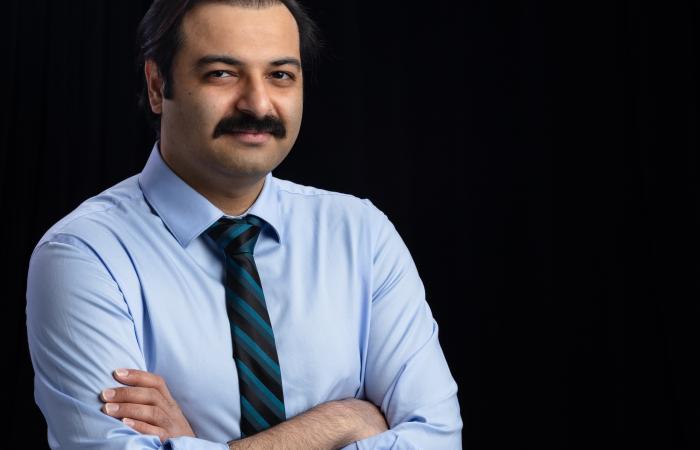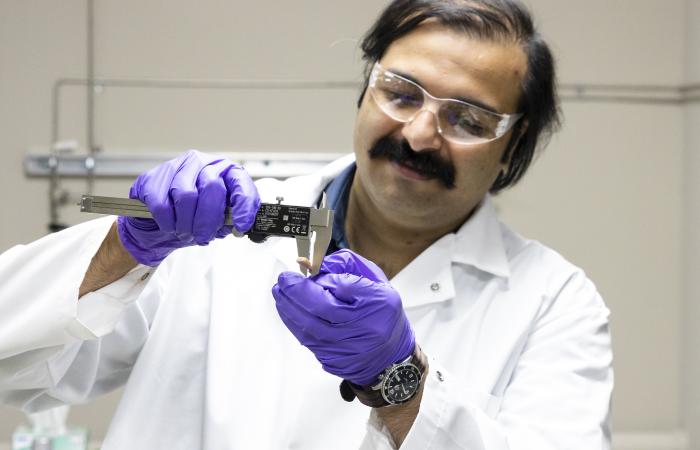-

Samarthya Bhagia is exploring the properties of biomass to convert plants into functional, sustainable materials for power electronics and sensing. Credit: Carlos Jones/ORNL, U.S. Dept. of Energy
-

Samarthya Bhagia examines a sample of a thermoplastic composite material additively manufactured using poplar wood and polylactic acid. Credit: Carlos Jones/ORNL, U.S. Dept. of Energy
-

Samarthya Bhagia is exploring the properties of biomass to convert plants into functional, sustainable materials for power electronics and sensing. Credit: Carlos Jones/ORNL, U.S. Dept. of Energy
-

Samarthya Bhagia examines a sample of a thermoplastic composite material additively manufactured using poplar wood and polylactic acid. Credit: Carlos Jones/ORNL, U.S. Dept. of Energy
Chemical and environmental engineer Samarthya Bhagia is focused on achieving carbon neutrality and a circular economy by designing new plant-based materials for a range of applications from energy storage devices and sensors to environmentally friendly bioplastics.
His research is aimed at reducing the use of carbon-emitting fossil fuel feedstocks in the making of plastics and other materials. This work can likewise advance materials recycling and biodegradability and help resolve the negative impacts from hazardous chemicals leaching into the environment from petrochemical-based plastics.
Bhagia has been leading several projects at the Department of Energy's Oak Ridge National Laboratory using advanced microscopy, spectroscopy, neutron scattering, 3D printing and other techniques to explore what's possible with biomaterials.
He is currently engaged in a deep dive into the chemistry and nanostructure of poplar biomass to analyze its electrical and other properties. That knowledge can be used to engineer plants to deliver desired qualities for soft actuators, environmental sensors and energy storage materials, for instance.
He also recently completed a project studying the structural and chemical properties of new thermoplastic biocomposites, including how to best design them for 3D printing with improved strength and durability, biodegradability, and recycling and upcycling potential.
"We're creating completely new synthesized materials, looking at plants and woody biomass in a new way that no one has done before," Bhagia said. "Getting the kind of advanced functionality we want from biomass is a novel approach and a difficult one. But with the current push for renewable products by our sponsors, industry and the public, we could see tremendous growth in this area."
Reaching carbon neutrality
"The goal is ultimately to create materials with a neutral carbon cycle, reducing the carbon dioxide emitted during manufacturing, while decreasing waste and improving the circular economy," he said.
Bhagia brings a background steeped in biomass characterization and conversion to biofuels and bioplastics to his work.
The son of doctors in New Delhi, India, he grew up hearing biology discussed around the house. He excelled at math and biology and eventually pursued a career as a research scientist. Bhagia received his undergraduate degree in pharmaceutical chemistry and technology from the Institute of Chemical Technology, or ICT, in Mumbai.
At that time, biofuels research was taking off, and Bhagia worked in biodiesel production from algae at ICT. That work led him to pursue graduate studies at the University of California, Riverside, or UCR, where he studied with Charles Wyman, a professor and expert in the conversion of biomass to cellulosic ethanol who also participated in the DOE BioEnergy Science Center led by ORNL.
After earning a doctorate in chemical and environmental engineering at UCR, Bhagia wanted to dive into something different: a focus on chemistry and the fine structures of plant lignin and polysaccharides. He took a position as a postdoctoral researcher at the University of Tennessee under the tutelage of Art Ragauskas, UT-ORNL Governor's Chair for Biorefining and a leading authority in natural biopolymers for biobased fuels, materials and chemicals.
Two years later, Bhagia began working as a postdoc at ORNL, where he helped develop 3D-printing processes for wood-filled composite materials, explored new plant-based polymers and performed characterization research for the ORNL and University of Maine collaboration to use more forest products in large-scale additive manufacturing. He was hired as research and development staff at ORNL in 2022.
Right capabilities, questioning attitude
"We have the right capabilities at ORNL to revolutionize what's possible with natural polymers for new, functional, sustainable materials," Bhagia said. "For good quality research we need good quality instruments, including large facilities like the Center for Nanophase Materials Science and the Spallation Neutron Source," both DOE Office of Science user facilities at ORNL. "I can also access colleagues here who are experts in many areas relevant to my research. I feel well supported at the lab."
For Bhagia, science is a passion. "Solving these big problems is difficult but also entertaining," he said. "You can realize a scientific breakthrough that moves the whole world forward."
His advice for up-and-coming scientists? "Start questioning. Put a 'why' in front of everything. That's when you get the clarity of the phenomenon that you're studying and how the science can be moved ahead."






